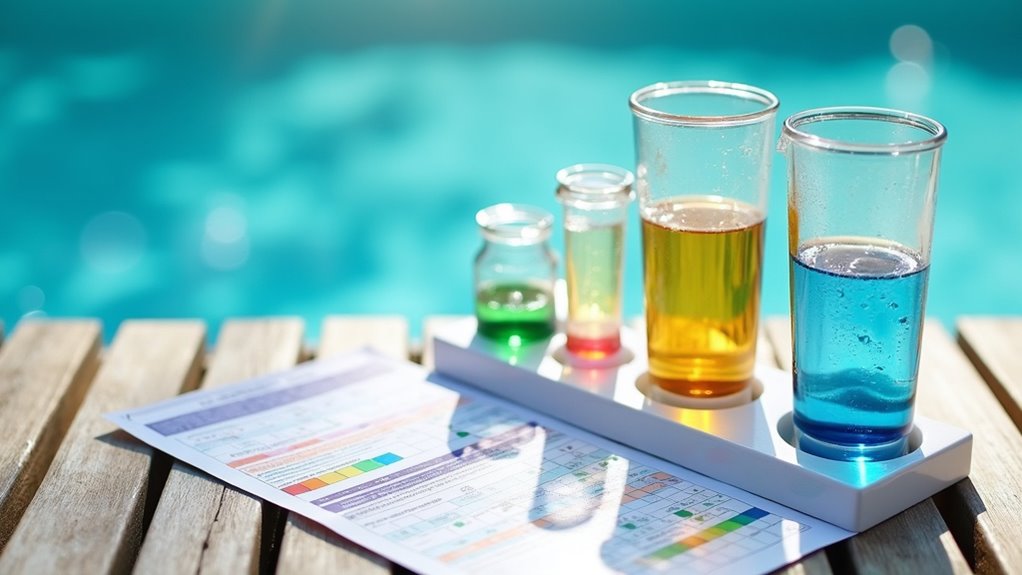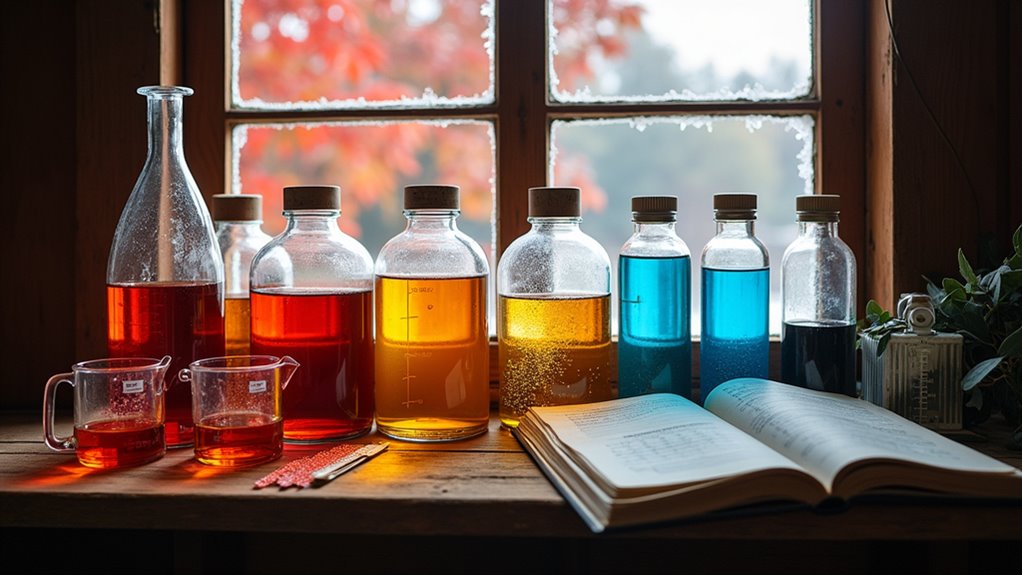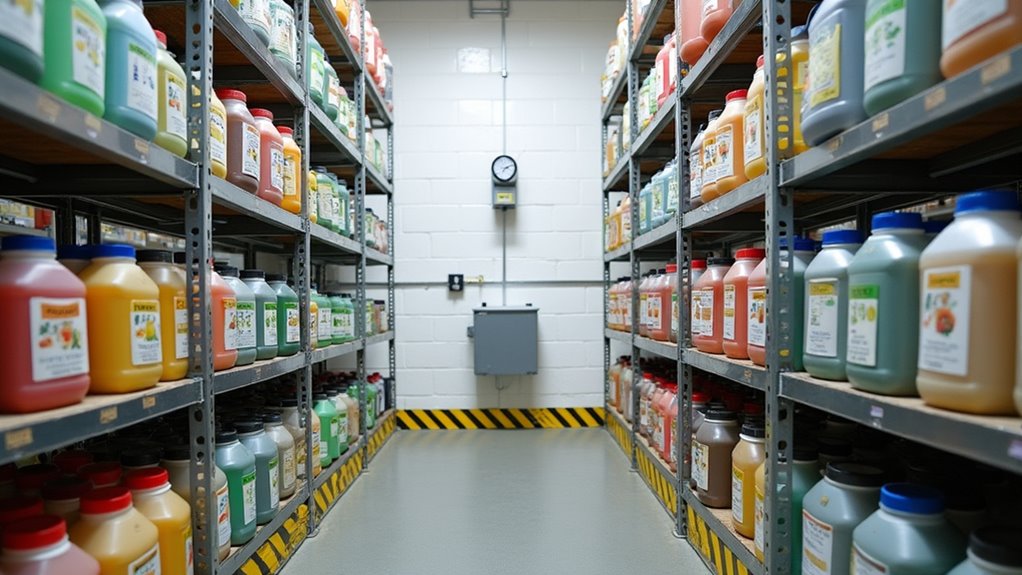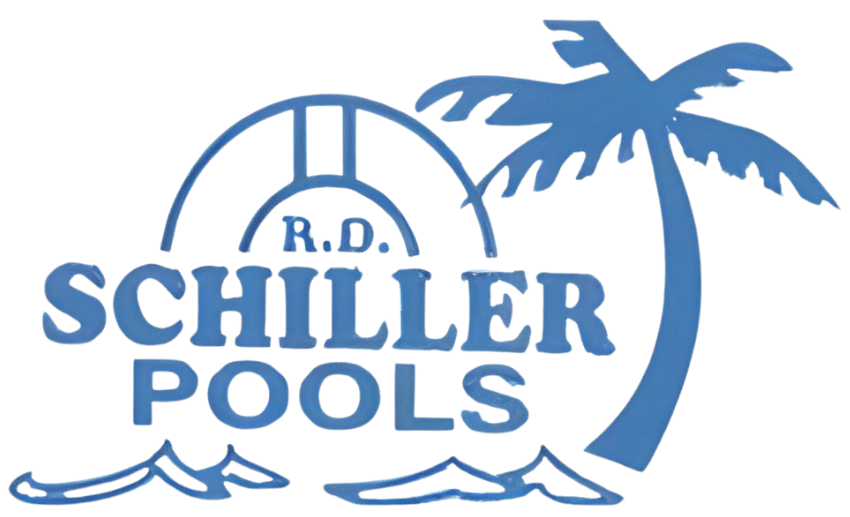Maintain a rigorous seasonal chemical maintenance schedule for your pool and lawn care needs. You’ll need to test pool water 2-3 times weekly, adjusting pH (7.2-7.6), chlorine (1-3 ppm), and alkalinity (80-120 ppm) levels accordingly. For lawn care, apply pre-emergent herbicides in early spring, balanced fertilizers in summer, and winterizer treatments in late fall. Proper chemical storage and safety protocols are crucial year-round. This thorough approach guarantees excellent results for your outdoor investments.
Essential Spring Chemical Testing and Treatment

As winter gives way to spring, proper chemical testing and treatment become critical for maintaining a safe, balanced pool environment. You’ll need to circulate your water for 24 hours before testing to guarantee accurate readings, then sample from 12-18 inches below the surface. Testing helps identify phosphates and nitrates that can promote unwanted algae growth. Regular testing should occur two to three times weekly for optimal chlorine and pH monitoring. Using test strips provides beginners with an easy-to-follow testing method.
Focus on achieving ideal ranges: free chlorine at 1-3 ppm, pH between 7.2-7.6, and alkalinity at 80-120 ppm. Spring often requires increased backwash filter frequency to handle post-winter debris and metal buildup removal from winter stagnation. Test using reliable methods and record your results systematically.
Start with a shock treatment to eliminate lingering contaminants, then adjust chemicals methodically. Pay special attention to cyanuric acid levels, which often drop due to spring rains, and maintain calcium hardness between 200-400 ppm to prevent corrosion or scaling.
Summer Pool Maintenance and Chemical Balancing
Summer’s intense heat and increased pool usage demand a more rigorous chemical maintenance schedule than spring. You’ll need to test your water 2-3 times weekly, monitoring pH (7.4-7.6), alkalinity (80-120 ppm), and chlorine (1-3 ppm) levels for optimal algae prevention and equipment preservation. Fiberglass pool owners can expect lower maintenance needs due to their algae-resistant surfaces.
Pay close attention to your chlorine levels, as they’ll deplete faster due to UV exposure and heavy swimmer loads. Add chemicals separately while the pump runs, and maintain proper pH balance to safeguard chlorine effectiveness. Maintaining proper calcium hardness between 200-400 ppm helps prevent surface damage and equipment scaling. You’ll likely need more frequent shock treatments to combat organic contaminants and combined chlorine. Using a test strip for regular monitoring provides quick and reliable results.
For best results, brush pool surfaces regularly, remove debris promptly, and backwash your filter as needed. Using stabilizers like cyanuric acid can help protect your chlorine from rapid UV degradation.
Fall Chemical Applications and Winter Prep

When temperatures begin dropping in fall, your lawn care focus shifts to strategic chemical applications that prepare turf for winter dormancy. Apply post-emergent herbicides with surfactants while weeds are actively growing, and include marker dye for precise coverage. Follow with preemergent herbicide application to prevent spring weed emergence. This timing is crucial since soil temperatures between 60 to 70 degrees provide optimal conditions for preemergent effectiveness.
Time your fertilizer applications strategically; start with a balanced starter fertilizer in early September, then move to slow-release nitrogen blends. Fall Rejuvenator applications help replenish vital nutrients and support recovery from summer stress. Before the first hard freeze, apply dormant oil insecticide treatment to control overwintering pests. Complete your winterization program with a final fertilizer application using a specialized winter blend with reduced nitrogen inputs to minimize disease pressure.
Remember to drain irrigation systems and adjust mowing height appropriately. Monitor treated areas for effectiveness and maintain proper watering schedules until ground freeze occurs.
Lawn and Garden Chemical Requirements by Season
Successful lawn and garden maintenance requires precise chemical applications customized to each season’s unique challenges. Before applying any treatments, you’ll want to conduct soil testing to determine pH levels and nutrient needs. Your chemical program should align with seasonal growth patterns and pest pressures. Core aerate the soil in spring or fall to improve root growth and reduce compaction. In late October or early November, apply a winterizer fertilizer to prepare the lawn for dormancy. Following the blooming of forsythia plants provides the ideal timing for applying pre-emergent herbicides.
| Season | Primary Treatments | Key Timing |
|---|---|---|
| Spring | Pre-emergent herbicides, nitrogen-rich fertilizer | 55-70°F soil temps |
| Summer | Post-emergent herbicides, grub control | Active growth period |
| Fall | High-nitrogen fertilizer, disease management | Labor Day window |
For cool-season grasses, focus your major fertilizer applications in early fall, while warm-season varieties benefit from early spring treatments. You’ll need to monitor for disease pressure during periods of high humidity, applying fungicides when necessary. Always coordinate chemical applications with cultural practices like aeration and overseeding to optimize effectiveness.
Proper Storage and Safety Guidelines Year-Round

Maintaining a safe chemical storage system requires painstaking organization and strict adherence to safety protocols throughout the year. You’ll need to conduct regular chemical inventory audits, guarantee proper segregation by hazard class, and implement sturdy spill containment procedures. Store your chemicals in approved cabinets away from heat and sunlight, using compatible containers with clear, legible labels that include dates received and opened. Federal regulations require having Safety Data Sheets readily available for all chemicals in storage. All hazardous chemicals must be stored below eye level for safety and easy access. Regular annual safety reviews of laboratory practices help ensure ongoing compliance with regulations and standards.
- Keep your flammables in designated fire-safe cabinets with self-closing doors, and store acids and bases separately to prevent dangerous reactions
- Install secondary containment systems like trays or pans under liquid chemicals to catch potential leaks
- Monitor storage areas consistently for signs of container damage, overcrowding, or improper temperature conditions
Remember to maintain readily accessible emergency equipment and clearly posted contact information for immediate response to incidents.
Frequently Asked Questions
How Long Should I Wait Between Adding Different Types of Pool Chemicals?
You’ll need to wait 4-8 hours between most pool chemical additions, but prolong this to 12 hours when using Cal Hypo shock. For ideal application intervals, add stain preventers initially, followed by clarifiers, then wait 8-12 hours before shocking. Always add just one chemical at a time with proper chemical storage between uses. Wait until chlorine levels drop below 3 ppm before adding algaecide to guarantee maximum effectiveness.
Can I Use Last Season’s Chemicals if They Appear Unchanged?
Don’t rely solely on visual appearance when deciding to use last season’s chemicals. Chemical shelf life considerations extend beyond what you can see, as degradation can occur invisibly. You’ll need to check the manufacturer’s expiration dates and Safety Data Sheet for proper chemical storage duration guidelines. If you’re unsure about a chemical’s integrity, it’s safer and more cost-effective to replace it than risk using potentially compromised products.
What Chemicals Can Safely Be Mixed Together During Application?
You’ll need to strictly follow product labels and compatibility charts when mixing chemicals. Start with water-soluble products, then add wettable powders, followed by liquids while maintaining constant agitation. Always perform a jar test before mixing new combinations. Proper storage procedures between uses and disposal recommendations are critical; keep chemicals in original containers and dispose of unused mixtures according to local regulations.
How Do I Adjust Chemical Dosages for Unusual Weather Conditions?
You’ll need to carefully adjust chemical ratios based on real-time water quality data during unusual weather events. Start by monitoring chemical interactions through jar testing to determine ideal dosages for current conditions. Increase coagulant doses when facing high turbidity from storms, but watch for diminishing returns. Track TOC levels and temperature changes, as they’ll affect chemical efficacy. Use continuous monitoring systems to fine-tune your adjustments throughout the weather event.
When Should I Replace My Chemical Testing Equipment?
You’ll need to replace your testing equipment based on your manufacturer’s equipment maintenance schedule, typically every 1-2 years for digital testers and annually for test strips. Don’t wait for complete failure; watch for signs like inconsistent readings or difficult calibration. Store your equipment in proper storage conditions (cool, dry place) to extend its life. If you’re using the equipment frequently or in harsh conditions, you may need more frequent replacements.






